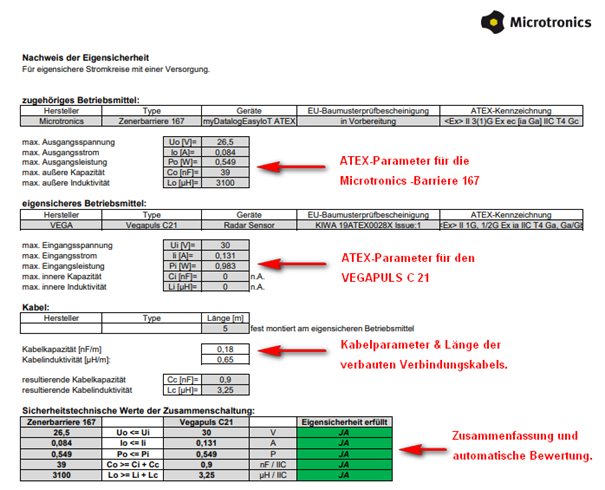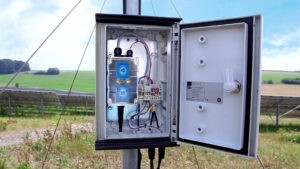An important point when installing intrinsically safe equipment is the verification of intrinsic safety (IS). This is so important because every plant operator must ensure that workers in the plant are not endangered or even injured. When using protection type Ex i, a precise documentation of the installed devices, wiring and connections must be prepared.
For intrinsically safe circuits consisting of equipment from a wide variety of manufacturers and types, this proof of intrinsic safety is often not easy to realise!
It must be checked that the interconnected units are operated safely and that no hot surfaces and ignitable sparks can occur.
How do you do this in practice for your desired sensor?
Let’s look at a concrete example. Suppose you want to operate a myDatalogEASY IoT ATEX in combination with the VEGAPULS C 21 level radar sensor. The sensor should be located in ATEX Zone 0.
1. Check the ATEX zone
Use the EC type examination certificates to check whether the sensor and the data logger (or the installed barriers) are suitable for operation in the desired zone.

Since the Equipment Protection Level (EPL) here is called “Ga”, operation in zone 0 is permissible.
The G stands for “gases, vapours and mists”. The second letter indicates the level of protection. This is divided into three levels:
- EPL Ga -> very high protection level | can be used in zone 0, 1, 2
In normal operation, there is no danger of ignition in the event of foreseeable or infrequent faults. - EPL Gb -> high protection level | usable in zone 1, 2
In normal operation, there is no danger of ignition in the event of foreseeable faults. - EPL Gc -> extended protection level | usable in zone 2
There is no danger of ignition during normal operation. Additional measures are taken so that there is also no danger of ignition in the event of foreseeable malfunctions.
2. Determine electrical ATEX parameters
Determine the electrical ATEX parameters for the intrinsically safe signals. These can be found in the EC type-examination certificate:

3. Selection of the appropriate zener barrier
Based on the ATEX sensor parameters, the appropriate Microtronics generator barrier can now be selected for the myDatalogEASY IoT ATEX.
As already shown in the article “Use of intrinsically safe ATEX equipment – Where and how may I install what?”, the selection is made according to the following table:
| Electrical parameters (according to EC type-examination certificate) | |||||
| Associated equipment | cables and lines | Intrinsically safe equipment | |||
| max. Output voltage | Uo | <= | Ui | max. Input voltage | |
| max. Output current | Io | <= | li | max. Input current | |
| max. Output power | Po | <= | Pi | max. Input power | |
| max. External inductance | Lo | >= | Lc (Cable inductance) + | Li | max. inner inductance |
| max. external capacity | Co | >= | Cc (Kabelkapazität) + | Ci | max. interior capacity |
In our example, the myDatalogEASY IoT ATEX represents the “associated equipment” – >Uo, Io, Po, ….
The radar sensor is the “intrinsically safe equipment” -> Ui, Ii, Pi, …
In our specific case, the Zener barrier type “167” is therefore the best solution.

Note:
From a technical point of view, the type with the lowest series resistance is to be preferred, as this results in the lowest series voltage drop in the mA signal loop (including the external and internal loads).
This is also an important factor for choosing the “most efficient” sensor supply voltage!
4. Proof of intrinsic safety
Microtronics provides a suitable template as an aid for the verification of intrinsic safety. Here you can enter the corresponding parameters and values very conveniently. The necessary documentation is thus quickly done.

Note:
- If all five fields in the template are GREEN, the combination of equipment is intrinsically safe. It can thus be used in the plant or machine.
- If one of the fields is RED, thecombination of equipment is not intrinsically safe and another barrier type must be used or the cable length must be adjusted.
Do you also need proof of intrinsic safety?
Although documentation is essential for this, implementation can still be fun with a convenient solution. Microtronics provides you with a suitable template and the documentation is done in no time.
Conclusion
With the appropriate documentation for the equipment, nothing stands in the way of correct installation and documentation of the system.
Microtronics offers support for common sensors. The calculated proof of intrinsic safety in combination with Microtronics ATEX products and barriers for simple intrinsically safe circuits is provided. You can find these verifications, for example, in the download area for the myDatalogEASY IoT ATEX and the myDatalogEx.


